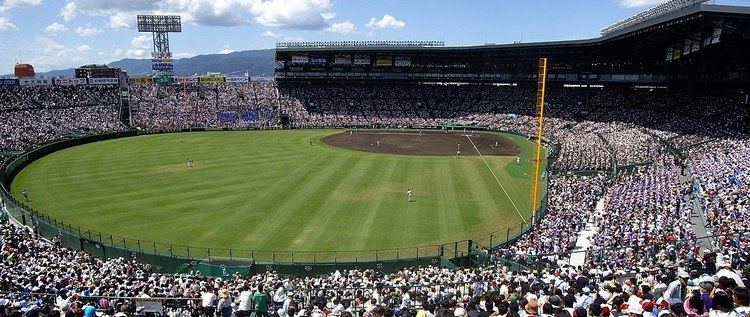Opened 1 August 1924 | ||
 | ||
Former names Koshien Large Sports Field (1924–)Koshien Stadium (–1964) Capacity approx. 60,000 (from the opening)approx. 80,000 (after the completion of all the seats)approx. 55,000 (–2001)approx. 53,000 (2003)50,454 (2002, 2004–2007)46,229 (2008)47,808 (2009–2011)47,757 (2012–)[1] Field size 1924–1949Foul line: 110m (360 ft)Power alley: 128m (420 ft)Center: 120m (394 ft)1949–1991Foul line: 91m (299 ft)Power alley: 119m (390 ft)Center: 120m (394 ft)as of 2011Foul line: 95m (311 ft)Power alley: 118m (387 ft)Center: 118m (387 ft)Ground area: approx 13,000m² Address Japan, 〒663-8152 Hyogo Prefecture, Nishinomiya, 甲子園町1−82 Hours Open today · 12:30PM–1:35AMFriday12:30PM–1:35AMSaturday12:30PM–1:35AMSunday12:30PM–12AMMonday(Vernal Equinox Day)12:30PM–1:35AMHours might differTuesday12:30PM–1:35AMWednesday12:30PM–1:35AMThursday12:30PM–1:35AM Similar Kōshien Station, Meiji Jingu Stadium, Kyocera Dome, Nagoya Dome, MAZDA Zoom‑Zoom Stadium Profiles | ||
Hanshin tigers koshien stadium
Hanshin Koshien Stadium (阪神甲子園球場, Hanshin Kōshien Kyūjō) is a baseball park located near Kobe in Nishinomiya, Hyōgo Prefecture, Japan. The stadium was built to host the national high school baseball tournaments, and opened on August 1, 1924. It was the largest stadium in Asia at the time it was completed, with a capacity of 55,000.
Contents
- Hanshin tigers koshien stadium
- Release of balloons during lucky 7th inning hanshin tigers koshien stadium
- Repairs
- Price ranges
- Appearances in fiction
- Access
- References
The name Kōshien (甲子園) comes from the Sexagenary cycle system. The year of the stadium's founding, 1924, was the first year kōshi (甲子) in the cycle. The design of the stadium was heavily influenced by the Polo Grounds in New York City. In 1936 it became the home stadium for the Osaka Tigers (current Hanshin Tigers), now with the Central League. On February 14, 1964, Hanshin, the Tigers' owners, was appended to the name of Koshien Stadium.
In addition to the annual National High School Baseball Championship, played in August, the stadium hosts the annual National High School Baseball Invitational Tournament in March, a smaller, invitational tournament. Both tournaments are generally known simply as Kōshien. The high school tournaments are given a higher priority, with any tournament games that need to be rescheduled forcing the Tigers to postpone conflicting home games. It also hosts Japan's American college football national championship game, the Koshien Bowl.
Legendary baseball player Babe Ruth played an exhibition game at Koshien on his Japan tour in 1934. There is a plaque at the stadium commemorating the event.
Release of balloons during lucky 7th inning hanshin tigers koshien stadium
Repairs
The Great Hanshin earthquake of 1995 affected Kōshien. Cracks appeared and part of the stands collapsed. In July 2004, a concrete plan surfaced for improvement of the complete baseball ground facilities.
Construction began during the off-season of 2008 while the stadium continued to be used for baseball. Later stages followed during the off-season, and the large-scale construction was completed in 2010.
The main points of the plan are as follows:
Price ranges
The stadium has four seating price ranges.
The top seats are the green seats (sold in season tickets) directly behind home plate and under the Ginsan roof. These seats are entirely covered and corporate. The seats in the infield are colored green on the first base side and the third base side under the Ginsan roof and called "Ivy Seat." Both sides are ¥4,000. The outfield benches along the lines are called the "Alps" and they are ¥2,500. The outfield seats are ¥1,900.
As with all Japanese stadiums, the home supporters sit in right field and the away supporters in left field. However, even if the opponents are the Yomiuri Giants, the away supporters rarely constitute more than one section high up in left field. On most nights the stadium is jam-packed with cramped seating.
Appearances in fiction
Koshien plays a big part in many baseball manga series, including Touch, Cross Game and H2 by Mitsuru Adachi and in other author's works like Higuchi Asa's Ōkiku Furikabutte and Rookies by Masanori Morita and Ace of Diamond by Yuji Terajima. It was talked about in Major where Koshien is the aim of all high school baseball teams to play there.
The park plays a part, in name, in the anime Princess Nine. The events of the two-hour Detective Conan special episode "Miracle at Koshien Ball Park! The Defiants Face the Dark Demon" take place in the stadium. In the light novel and anime adaptation of Melancholy of Haruhi Suzumiya (specifically the episode "Melancholy of Haruhi Suzumiya Part 5"), Haruhi's explanation of why she searches for the supernatural involves a baseball game she viewed with her family in Koshien.
The stadium appears as a stage in the fighting game The King of Fighters '97, crowded and adapted for the KOF tournament, with the fighters standing on a catwalk-like structure. In Nodame Cantabile, the heroine Megumi Noda kept a bag of soil from Koshien Stadium. In Angel Beats! Hinata says he was part of a baseball team that was aiming to play in Koshien. In Silver Spoon, Ichiro Komaba is determined to get his baseball team to Koshien to go pro and make money for his family farm.
Access
Koshien Stadium is a two-minute walk from Koshien Station on the Hanshin Electric Railway Main Line. There is no parking lot at the stadium. Regular television commercials during game broadcasts encourage the public to use public transportation.
